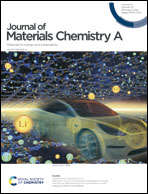A general acetic acid vapour etching strategy to synthesize layered carbon nitride with carbon vacancies for efficient photoredox catalysis†
Abstract
Polymeric carbon nitride (PCN) semiconductors are appealing light-transducers for photocatalytic redox reactions owing to their unique band gap and stability. However, pristine PCN exhibits moderate efficiency due to the low surface area and serious charge recombination. The delamination of PCN into few-layered nanosheets is an effective strategy to improve the reaction efficiency, but remains a huge challenge. Herein, we report a general approach to prepare few-layered PCN nanosheets by an acetic acid vapor etching strategy. The bulk PCNs obtained from typical precursors including melamine, dicyandiamide, and trithiocyanuric acid can be exfoliated into few-layered nanosheets, while their surfaces can be engineered to present carbon vacancies (CVs). Results confirm that the few-layered nanosheets endow PCN with abundant reactive sites, effective charge separation, and prolonged charge lifetime. Furthermore, experimental and theoretical calculation results verify that the CVs within PCN nanosheets can facilitate electron transfer from the PCN nanosheets to the Pt cocatalyst, significantly lowering the reaction barrier for the formation of H* species. As a result, the PCN nanosheets (with Pt as a cocatalyst) exhibit excellent photocatalytic activity for hydrogen production with visible light. The apparent quantum yield (AQY) for hydrogen production at 400 nm reaches as high as 16.22%, exceeding most of the reported AQY values of PCN-based photocatalysts for hydrogen production. Moreover, it was found that the CVs within PCN nanosheets are favorable for the adsorption and activation of O2 molecules owing to the delocalization of the non-bonding electrons around defects to the absorbed O2, considerably expediting the reaction kinetics of phenol degradation under visible light. This work not only provides a general methodology for the synthesis of few-layered PCN nanosheets but also establishes the connection between the catalyst structure and performance.



 Please wait while we load your content...
Please wait while we load your content...